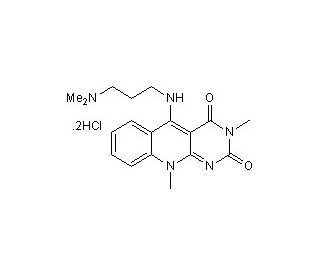

HLI 373 (CAS 502137-98-6)
Produktreferenzen ansehen (1)
Available in US only.
Direktverknüpfungen
HLI 373 ist ein Inhibitor der Hdm2-Ubiquitin-Ligase (E3), der die Hdm2-vermittelte Ubiquitinylierung blockiert, die Proteasom-abhängige Degradation von p53 aktiviert und die p53-abhängige Transkription aktiviert. Darüber hinaus induziert es Apoptose in mehreren Tumorzelllinien (LOX-IMVI, A549 und HT1080), die Wildtyp-p53 exprimieren. HLI 373 ist eine Substanz, die die Aktivität der Hdm2-Ubiquitin-Ligase (E3) hemmt, die für die Förderung des Abbaus von p53 durch einen Prozess namens Ubiquitinylierung, gefolgt von Degradation im Proteasom, verantwortlich ist. Durch die Hemmung von Hdm2 verhindert HLI 373 die Ubiquitinylierung und die anschließende Degradation von p53, was zur Aktivierung der p53-abhängigen Transkription führt. Als Ergebnis induziert HLI 373 Apoptose (Zelltod) spezifisch in verschiedenen Tumorzelllinien, die das Wildtyp-p53-Gen besitzen.
HLI 373 (CAS 502137-98-6) Literaturhinweise
- Zielgerichtete Behandlung von Tumorzellen, die p53 exprimieren, mit einem wasserlöslichen Inhibitor von Hdm2. | Kitagaki, J., et al. 2008. Mol Cancer Ther. 7: 2445-54. PMID: 18723490
- Das Ubiquitin-Proteasom-System als Ziel für die Krebstherapie. | Yang, Y., et al. 2009. Cancer Sci. 100: 24-8. PMID: 19037995
- Eine vergleichende Analyse der Ubiquitinierungskinetik mehrerer Degrons zur Ermittlung einer idealen Zielsequenz für einen Proteasom-Reporter. | Melvin, AT., et al. 2013. PLoS One. 8: e78082. PMID: 24205101
- Inhibitoren der Ubiquitin-E3-Ligase als potenzielle neue Wirkstoffe gegen Malaria. | Jain, J., et al. 2017. BMC Pharmacol Toxicol. 18: 40. PMID: 28577368
- MDM2 fördert den epithelial-mesenchymalen Übergang und die Metastasierung von SKOV3-Eierstockkrebszellen. | Chen, Y., et al. 2017. Br J Cancer. 117: 1192-1201. PMID: 28817834
- Ubiquitin-abhängige Proteolyse von CXCL7 führt zur Verknöcherung des hinteren Längsbandes. | Tsuru, M., et al. 2018. PLoS One. 13: e0196204. PMID: 29782494
- Genetische Veränderungen beim anaplastischen Schilddrüsenkarzinom und gezielte Therapien. | Li, Z., et al. 2019. Exp Ther Med. 18: 2369-2377. PMID: 31555347
- Carboran als alternative, effiziente hydrophobe Markierung für den Proteinabbau. | Asawa, Y., et al. 2021. Bioconjug Chem. 32: 2377-2385. PMID: 34699716
- Pharmakologische Modulation der Ubiquitin-Proteasom-Wege in der onkogenen Signalgebung. | Sharma, A., et al. 2021. Int J Mol Sci. 22: PMID: 34769401
- MAGED2 ist unter Hypoxie für die cAMP-Signalgebung erforderlich, indem es die MDM2-abhängige Endozytose von G-Alpha-S hemmt. | Seaayfan, E., et al. 2022. Cells. 11: PMID: 36010623
- Erstellung und Validierung einer mit dem Cholesterinstoffwechsel zusammenhängenden prognostischen Signatur für das hepatozelluläre Karzinom. | Tang, L., et al. 2022. Comput Struct Biotechnol J. 20: 4402-4414. PMID: 36051877
- Entwicklung einer Einzelmolekül-Ubiquitinierungs-vermittelten Fluoreszenzkomplementierung zur Visualisierung der Dynamik der Protein-Ubiquitinierung in Dendriten. | Ifrim, MF., et al. 2022. Cell Rep. 41: 111658. PMID: 36384114
- Eine Plasmodium falciparum RING-Finger-E3-Ubiquitin-Ligase modifiziert die Rolle von PfMDR1 und PfCRT bei der Reaktion des Parasiten auf Medikamente. | Singh, BK., et al. 2023. Antimicrob Agents Chemother. 67: e0082122. PMID: 36625569
Bestellinformation
| Produkt | Katalog # | EINHEIT | Preis | ANZAHL | Favoriten | |
HLI 373, 10 mg | sc-358833 | 10 mg | $173.00 | |||
| USA: Nur in den USA erhältlich | ||||||
HLI 373, 50 mg | sc-358833A | 50 mg | $712.00 | |||
| USA: Nur in den USA erhältlich | ||||||
